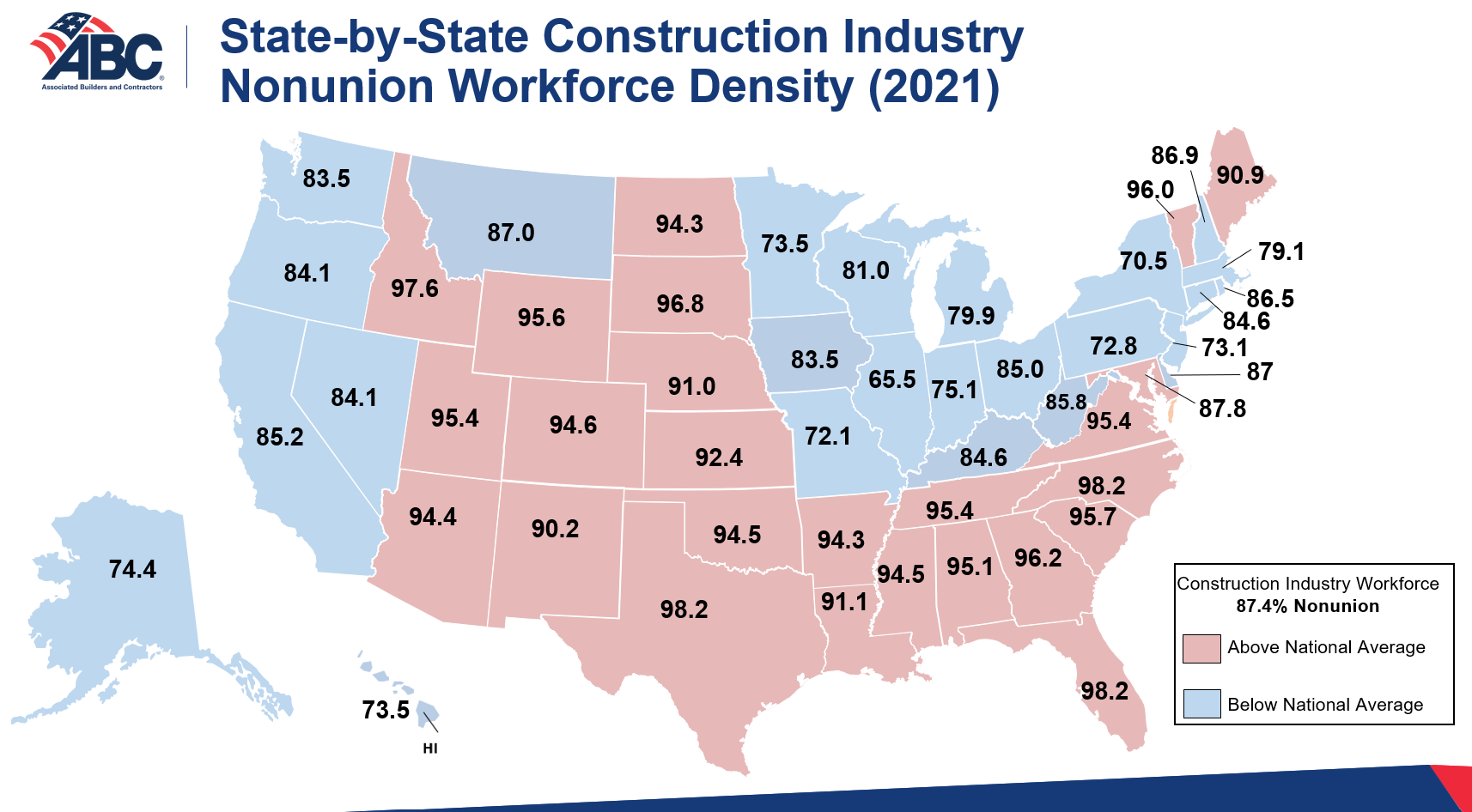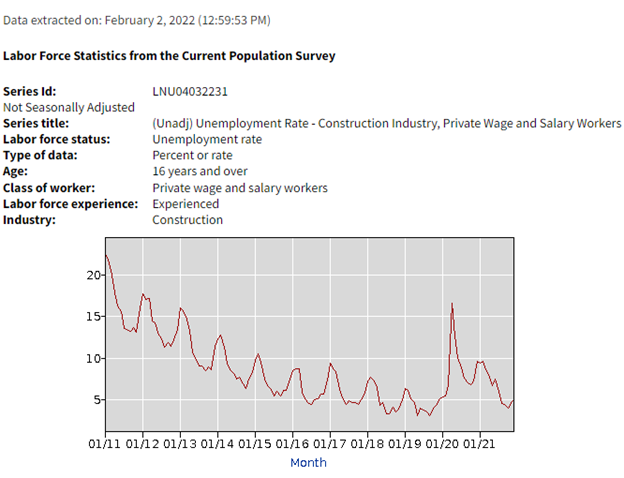BLS: 87.4% of Construction Industry Does Not Belong to a Union
The rate of union membership in the construction industry dropped slightly in 2021, from 12.7% to 12.6%, according to data from the U.S. Department of Labor’s Bureau of Labor Statistics’ annual union members summary report published on Jan. 20, 2022. However, construction unions added 31,000 members, growing from 993,000 in 2020 to 1.024 million in 2021.
The number of people working in the construction industry increased by 328,000 (8.157 million, up from 7.829 million in 2020), as a result of increased economic activity in 2021 following brief industry shutdowns and the economic downturn caused by the COVID-19 pandemic.
Union membership as a percentage of the construction industry has steadily declined throughout the last 75 years. In 1947, approximately 87% of its workforce was unionized. During the lowest point of the construction industry’s recession in 2010, just 801,000 construction industry workers belonged to a union (13.1%), the smallest number of union members in recent history.
In 2021, the number of private and public wage and salaried workers belonging to unions continued to decline to 14 million (-241,000), and the percentage who were members of unions was 10.3%, down from 10.8% in 2020. Union membership in the private sector across all industries dropped to 6.1% (7.03 million) in 2021 from 6.3% (7.08 million) in 2020.
Visit the BLS website to view the news release, data by occupation and industry and additional details.
Updated, state-specific union membership information for various U.S. industries, including the construction industry, is available at Table III of unionstats.com and PowerPoint maps of the below images are available here.


Construction Industry Confidence Up, Unemployment Down in 2021
The nonresidential merit shop construction sector continues to perform relatively well despite the pandemic. In a year-to-year comparison, the construction backlog increased to 8.2 months in December 2021 compared to 7.3 months in December 2020, according to ABC’s Construction Backlog Indicator. The latest ABC Construction Confidence Index, which measures sales, profit margins and staffing levels, increased by more than 10 points in a year-to-year comparison, indicating expectations of growth over the next six months.
The most recent BLS data pegs the construction industry unemployment rate at 5.0% for December 2021—the same number in December 2019 prior to the pandemic. In contrast, the construction industry unemployment rate was 27.1% in February 2010 at the peak of the Great Recession.

Government-Mandated PLA Schemes Increase Union Membership
Data on the construction industry’s union membership can impact the public policy debate surrounding anti-competitive and costly government-mandated project labor agreements on taxpayer-funded construction projects.
When mandated by lawmakers on construction projects, PLAs typically ensure construction contracts are awarded only to companies that agree to recognize unions as the representatives of their employees on that job; use the union hiring hall to obtain workers at the expense of most or all of its existing qualified employees; obtain apprentices exclusively through union apprenticeship programs; follow inefficient union work rules; pay into union benefit and multi-employer pension plans workers will never benefit from unless they meet vesting requirements; and force workers to pay union dues and/or join a union as a condition of employment.
Discouraging competition from qualified merit shop contractors and their skilled nonunion construction workforce via government-mandated PLAs costs taxpayers a fortune. When mandated by a government agency on taxpayer-funded projects, PLAs drive up the cost of construction projects anywhere from 12% to 20%, on average, according to a series of academic studies.
A study released in 2020 by the Beacon Hill Institute found that Connecticut schools built under controversial government-mandated PLAs cost 19.8% more than schools that were bid and constructed through fair and open competition, free from PLA requirements. Similar research by the Beacon Hill Institute on the impact of PLA mandates on school construction in New Jersey (2019), Ohio (2017), New York (2006) and Massachusetts (2006) found schools built with government-mandated PLAs were 12% to 20% more expensive compared to school projects not built with PLAs.
According to a model developed by Markstein Advisors, every $1 billion in extra overall construction spending generates an average of at least 6,500 construction jobs, and every $1 billion in extra construction spending on infrastructure generates an average of at least 3,300 construction jobs.
In 2021, the construction industry faced a shortage of 430,000 craft professionals, a number expected to grow in the coming months and years as baby boomers retire, the economy improves and an additional $550 billion of new federal investment in infrastructure as a result of the Infrastructure Investment and Jobs Act signed into law Nov. 15, 2021, puts additional stress on the industry’s need for skilled labor.
Lawmakers need to be doing all they can to maximize taxpayer investments in infrastructure by supporting inclusive policies that welcome all construction workers find quality jobs to rebuild their communities, regardless of labor affiliation.
As the Biden administration begins to implement the IIJA, ABC will continue to support H.R. 1284/S. 403, the Fair and Open Competition Act, which would prevent the federal government from mandating PLAs as a condition of winning federal or federally assisted construction contracts. ABC members are encouraged to visit the ABC Action Center and urge their members of Congress to support FOCA.
In 2022, ABC will continue to fight for federal, state and local policies that create a level playing field in the procurement of government construction contracts, increase competition, help small businesses grow, curb construction costs and create jobs and opportunities for all Americans and all qualified construction industry businesses.
Advocating for inclusive policies so all Americans and all qualified companies can rebuild America’s infrastructure is a win-win for taxpayers and the U.S. economy.












4 Responses to BLS: 87.4% of Construction Industry Does Not Belong to a Union
[…] trade unions because it leverages federal tax policy to boost union membership while penalizing the 87.4% of U.S. construction workers who have chosen to work for a nonunion contractor and not to join a […]
[…] trade unions because it leverages federal tax policy to boost union membership while penalizing the 87.4% of U.S. construction workers who have chosen to work for a nonunion contractor and not to join a […]
[…] trade unions because it leverages federal tax policy to boost union membership while penalizing the 87.4% of U.S. construction workers who have chosen to work for a nonunion contractor and not to join a […]
[…] trade unions because it leverages federal tax policy to boost union membership while penalizing the 87.4% of U.S. construction workers who have chosen to work for a nonunion contractor and not to join a […]